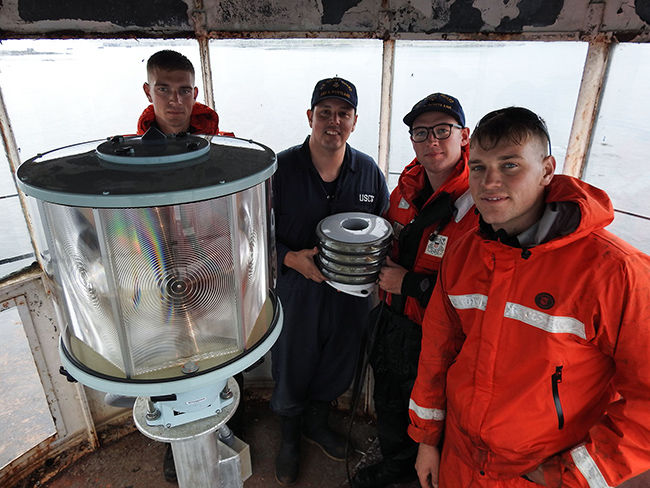Whaleback Light, Kittery, Maine
- Madeline

- Jan 3, 2023
- 4 min read
Updated: Jul 14, 2024

As you may know, Maine has the second most lighthouses in the States, behind only Michigan. The southernmost of Vacationland's lights is Whaleback Light in Kittery. In fact, some of the best vantage points of the light are from New Hampshire, not Maine.

A lighthouse was first built in 1820, on a rocky shoal located between Kittery, ME, and Newcastle, NH. The shoal is only visible during low tide but completely hidden at high tide, and sits at the wave-beaten entrance to the Piscataqua River--derived from the river's original name given by the Abenaki Native Americans. It is a tidal river and forms the boundary between the states of New Hampshire and Maine. This Whaleback Ledge was a common shipwreck location, the first of which was recorded in 1733.
It is unclear what this first lighthouse looked like or what the construction materials were--it may not even qualify as a lighthouse by today's standards. Regardless, the marker could not withstand such exposure to the elements. Less than a decade later, a second lighthouse was built on site in 1829.

This second light had a block foundation, likely granite due to its abundance in the area. A small, conical tower was constructed on the foundation topped by a small, hexagonal lantern. The tower stood at 40 feet tall and shone a fixed white light. Just six years after construction was complete, it was noted that the tower leaked in storms and had been poorly built. In 1855, the light was upgraded to a Fourth Order Fresnel lens. In 1863, a fog bell was added.
36 years after the faulty construction was first noted, a new tower was built entirely of granite in 1872. It stood at 50-feet tall with a characteristic of a flashing white light every 10 seconds. The tower was equipped with a foghorn, sounding 2 blasts every 30 seconds. The second generation lighthouse tower from 1829 was not removed until 1880, so two towers shared the small rocky Whaleback Ledge for 8 years. Today, the foundation from the 1829 tower still remains.

It's amazing to think about the lighthouse keepers and their families isolated in hostile waters like at Whaleback. It's easy to overlook that these lighthouses weren't just important navigational aids, but also the extent of a family's workplace, living quarters, school, and playground all in one. If you scroll to the end of the blog, you'll see the long list of keeper's at Whaleback. It's no wonder many of them only lasted a few years.

Keeper Leander White's experience in an 1886 storm well illustrates how difficult life could be at Whaleback. A violent storm surge sent waves crashing into the light. A window shattered and water poured into the tower. It began to flood with the water rising higher and higher in the tower. White sought safety in the lantern room and used a blanket to signal for help. He was eventually rescued and taken to shore for medical treatment. Interestingly White's savior, Captain Walter Amee, later became the longest serving head keeper of Whaleback.

Whaleback received a new lens in 1912 and the characteristic was adjusted to two quick flashes every 10 seconds. The light utilized a revolving bi-valve Fourth Order Fresnel lens with 2 bull-eye panels. This became the light's signature for the next 97 years. Although the 1912 Fresnel lens was replaced over time with multiple different aero beacons, the rotating double flash was maintained until 2009, when the USCG installed a light emitting diode beacon.

The change never sat well with locals, and residents on both sides of the river campaigned for years to restore Whaleback's signature double flash. Residents joined with mariners, the American Lighthouse Foundation, and the USCG until finally a rotating beacon was reinstalled at the tower on June 1, 2022.

Today, the tower is owned and managed by the American Lighthouse Foundation, and is still an active aid to navigation. The USCG manages the light itself and the fog horn. The lighthouse was added to the National Register of Historic Places in 1988.
As with many historic lighthouses, Whaleback is in need of some major restoration work, especially given its exposure to the elements on the Piscatagua River. The Foundation is actively raising money for and working on restoration projects piecemeal. Accessibility has been an ongoing issue, since the 2 breakwaters have been damaged or nonexistent for some time, and there is no docking system. The lantern was restored in 2020 by J.B. Leslie Company. Some additional restoration work was begun in 2022. Eventually, the Foundation plans to build a dock and open the light for public tours. Until then, you can cruise by on boat or view from the shore.

Sources:
Keepers:
Samuel E. Haskell (1831–1839)
Joseph L. Locke (1839–1840)
Zachariah Chickering (1840)
John Kennard (1840)
Joseph D. Currier (1841)
Eliphalet Grover (1841–1843)
J. Prentiss Locke (1843-unknown)
Richard R. Lock (c. 1847)
Jedediah Rand (1849–1853)
Reuben T. Leavitt (1853–1859)
Oliver P. Tucker (1859–1860)
Gustavus A. Abbott (1860–1861)
Joel P. Reynolds (1861–1864)
Nathaniel P. Campbell (1864)
Ambrose Card (keeper 1864)
Gilbert Amee (1864-1869)
James W. Verney (1869–1871)
Ferdinand Barr (1871)
William H. Caswell (1871–1872)
Chandler Martin (1872–1878)
Leander White (1878–1887)
Ellison C. White (1887-1888)
James M. Haley (1888–1893)
Walter S. Amee (1893–1921)
Arnold B. White (1921–1941)
W. A. Alley (c. 1935)
Maynard F. Farnsworth (c. 1922-1940s)
Charles U. Gardner (relief keeper, c, 1942–1943)
Morgan W. Willis (1948-1950)
Francis D. Hickey (Coast Guard, c. 1956-1957)
Robert Brann (Coast Guard, c. 1957)
Stephen H. Rogers (USCG, c. 1957-1958)
James Pope (Coast Guard, c. early 1960s)
Automated 1963



Comments